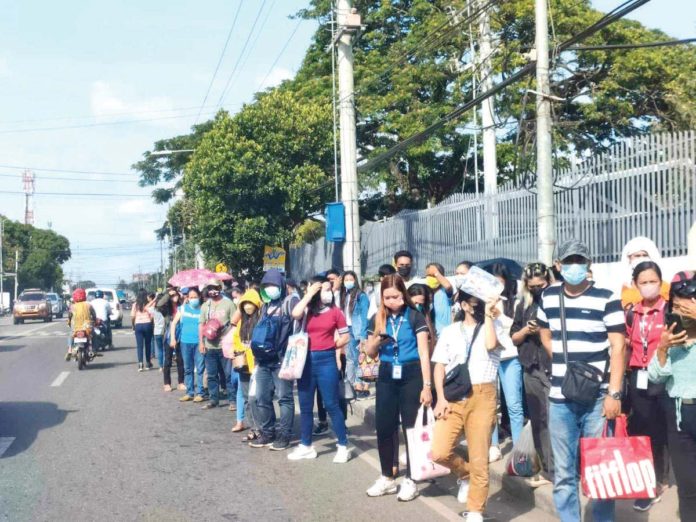
BY GEROME DALIPE IV
ILOILO City – Commuters queuing for hours waiting for minibuses at a private transport terminal here say they want sufficient and regular public transport, apart from the comfort provided by these modern vehicles.
“Anhon namon ang modern jeep kon malaka lang ang byahe during rush hours? Ang iban mga estudyante kag may senior citizens pa, ga tindog pila ka oras linya hulat sa modern jeep,” said Rena, a call center employee.
But it appears that the Land Transportation Franchising and Regulatory Board (LTFRB) and the Department of Transportation (DOTr) are prioritizing consolidation of operators into juridical entities, and not consolidation of operation via regular and organized transport services, the passengers noted.
In Western Visayas, LTFRB claimed to have achieved a 69.2 percent consolidation rate under the public utility vehicle modernization program (PUVMP), or 5,909 out of 8,534 jeepney units.
As one of the 10 components of the modernization program, consolidation will now allow juridical entities such as these transport corporations and cooperatives access to fresh capital needed to buy modern jeepneys estimated at P2.4 million per unit.
State-owned Land Bank of the Philippines (LBP) and the Development Bank of the Philippines (DBP) received P2.2 billion for this from the national budget during the term of former president Rodrigo Duterte.
The banks set the above funds as loan facilities for qualified transport entities as subsidies for “PUV owners when applying for loans to replace old public utility jeepneys with more efficient PUVs.”
Some disgruntled jeepney operators and drivers, who spoke to Panay News on condition of anonymity for fear of being chided by their officials, agreed to the passengers’ commuting experience. They admitted that their status is in survival mode, instead of improving their service to the riding public.
The operators, who felt being “forced” into consolidating their units for fear of losing their franchises, said they could now feel the pressure to earn more to pay off their vehicle loans.
Before the franchise consolidation, some jeepney drivers said they could rest after meeting their “boundary” for the day.
But with the fleet management system under the modernization program, the drivers said they are required to extend hours to meet the “quota” while also adjusting to the “rationalized” route of the program.
The jeepney operators and drivers observed the program focuses on franchise consolidation to “incentivize” cooperatives or corporations, but not to provide efficient and reliable public transport.
But can the LTFRB or DOTr be compelled to deliver an efficient transport system?
Under their mandates and responsibilities, these agencies are not required by law to ensure adequate and reliable public transport. Their tasks are mainly to promulgate programs and policies to empower entities to offer adequate public service.
The LTFRB, on the other hand, regulates fares, routes, and public vehicle units to ensure the riding public of adequate supply.
In Iloilo City, the Traffic Management Unit met with officials from transport entities and set up contingency measures for the enhanced route plan.
At least 1, 692 jeepneys consolidated into cooperatives in Iloilo City, or 75 percent, out of 2, 266 total traditional units.
The franchise consolidation process is among the 10 components of the modernization program.
Through consolidation, the LTFRB stressed that PUV units would be allocated equally to rationalized routes to prevent competition among drivers over the same route.
Under the program, drivers and operators are promised stable, sufficient, and dignified livelihoods while commuters get to their destinations quickly, safely, and comfortably.
The agency also said the program features regulatory reform and sets new guidelines for the issuance of franchises for road-based public transport services.
Under the program, the local government units are empowered to draft their route planning considering they are more versed in the terrain and passenger demand within their respective territorial jurisdiction.
In Bacolod City, only 620 jeepneys have consolidated out of 2,313 total numbers of traditional units (27 percent).
As the April 30 deadline ended, there are still about 21.1 percent or 69 jeepney routes in Western Visayas with no consolidated entities.
The majority of the jeepney routes without consolidated entities come from Negros Occidental, the LTFRB data showed.
Likewise, these unconsolidated routes are not yet covered by the Local Public Transport Route Plan (LPTRP).
Under LTFRB’s Memorandum Circular 2024-001 dated Jan. 31, 2024, consolidation of units for routes that are not yet covered by the route plan shall not be allowed if the number of unconsolidated units is below 40 percent of the total number of authorized units.
Essentially, units originally plying for these routes will be considered “colorum” vehicles starting May 1.
Chairman Teofilo Guadiz III announced that unconsolidated jeepneys have 15-day leeway to still ply their routes before the government starts impounding their vehicles.
The LTFRB will summon those who failed to consolidate and will be required to explain why they refused to participate in the government-sanctioned modernization program./PN





